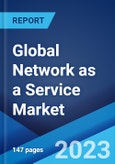The global network as a service market size reached US$ 14.3 Billion in 2022. Looking forward, the market is expected to reach US$ 77.6 Billion by 2028, exhibiting a growth rate (CAGR) of 32.56% during 2022-2028.
Network-as-a-Service (NaaS) is a cloud-based technological solution that involves the renting of networking services from service providers. It involves the hiring of hardware, software, management tools, lifecycle services and licenses without owning, building or maintaining the setup infrastructure. NaaS can aid in replacing hardware-centric virtual private networks (VPNs), load balancers, firewall appliances and multiprotocol label switching (MLPS) connections. The network infrastructure is also virtualized through flexible operating expenses (OpEx). The service is provided to the customers in exchange for a subscription and can be scaled as per the requirement of the user. As a result, it finds extensive applications across various industries, including banking, financial services and insurance (BFSI), retail, information technology (IT) and healthcare.
Network-as-a-Service (NaaS) is a cloud-based technological solution that involves the renting of networking services from service providers. It involves the hiring of hardware, software, management tools, lifecycle services and licenses without owning, building or maintaining the setup infrastructure. NaaS can aid in replacing hardware-centric virtual private networks (VPNs), load balancers, firewall appliances and multiprotocol label switching (MLPS) connections. The network infrastructure is also virtualized through flexible operating expenses (OpEx). The service is provided to the customers in exchange for a subscription and can be scaled as per the requirement of the user. As a result, it finds extensive applications across various industries, including banking, financial services and insurance (BFSI), retail, information technology (IT) and healthcare.
Network as a Service Market Trends
Significant growth in the IT industry across the globe is one of the key factors creating a positive outlook for the market. NaaS is widely used for video conferencing, operating VPNs, wide area network (WAR) optimization and running secure web gateways. Moreover, the widespread adoption of NaaS platforms by small, medium and large-sized organizations is providing a thrust to the market growth. The solutions are deployed on the cloud and on-premises for converting physical networking elements to sharable virtual resources. Additionally, various technological advancements, such as the integration of connected devices with the Internet of Things (IoT), virtual reality (VR) and augmented reality (AR) solutions, are acting as other growth-inducing factors. These technologies offer enhanced technological flexibility and data security to the organizations and improved access to private and public gateways. They also provide enhanced connectivity with smart devices, computing systems, remote offices and data centers. Other factors, including the increasing adoption of 5G technologies, along with the widespread adoption of a pay-per-use pricing model, are anticipated to drive the market toward growth.Key Market Segmentation
This research provides an analysis of the key trends in each sub-segment of the global network as a service market report, along with forecasts at the global, regional and country level from 2023-2028. The report has categorized the market based on type, application and end use industry.Breakup by Type:
- LAN-as-a-Service
- WAN-as-a-Service
Breakup by Application:
- Cloud-based Services
- Bandwidth on Demand
- Integrated Network Security-as-a-Service
- Wide Area Network
- Virtual Private Network
Breakup by End Use Industry:
- Healthcare
- BFSI
- Retail and E-Commerce
- IT and Telecom
- Manufacturing
- Transportation and Logistics
- Public Sector
Breakup by Region:
- North America
- United States
- Canada
- Asia-Pacific
- China
- Japan
- India
- South Korea
- Australia
- Indonesia
- Europe
- Germany
- France
- United Kingdom
- Italy
- Spain
- Russia
- Latin America
- Brazil
- Mexico
- Middle East and Africa
Competitive Landscape
The competitive landscape of the industry has also been examined along with the profiles of the key players being Akamai Technologies Inc., AT&T Inc., Broadcom Inc., Ciena Corporation, Cisco Systems Inc., GTT Communications Inc., Hewlett Packard Enterprise Development LP, International Business Machines Corporation, Juniper Networks Inc., Nokia Corporation, Oracle Corporation, Telstra Corporation Limited, Verizon Communications Inc. and VMware Inc. (Dell Technologies Inc.).Key Questions Answered in This Report:
- How has the global network as a service market performed so far and how will it perform in the coming years?
- What has been the impact of COVID-19 on the global network as a service market?
- What are the key regional markets?
- What is the breakup of the market based on the type?
- What is the breakup of the market based on the application?
- What is the breakup of the market based on the end use industry?
- What are the various stages in the value chain of the industry?
- What are the key driving factors and challenges in the industry?
- What is the structure of the global network as a service market and who are the key players?
- What is the degree of competition in the industry?
Table of Contents
1 Preface3 Executive Summary11 Value Chain Analysis13 Price Analysis
2 Scope and Methodology
4 Introduction
5 Global Network as a Service Market
6 Market Breakup by Type
7 Market Breakup by Application
8 Market Breakup by End Use Industry
9 Market Breakup by Region
10 SWOT Analysis
12 Porters Five Forces Analysis
14 Competitive Landscape
Companies Mentioned
- Akamai Technologies Inc.
- AT&T Inc.
- Broadcom Inc.
- Ciena Corporation
- Cisco Systems Inc.
- GTT Communications Inc.
- Hewlett Packard Enterprise Development LP
- International Business Machines Corporation
- Juniper Networks Inc.
- Nokia Corporation
- Oracle Corporation
- Telstra Corporation Limited
- Verizon Communications Inc.
- VMware Inc. (Dell Technologies Inc.)
Methodology

LOADING...
Table Information
| Report Attribute | Details |
|---|---|
| No. of Pages | 147 |
| Published | November 2023 |
| Forecast Period | 2022 - 2028 |
| Estimated Market Value ( USD | $ 14.3 Billion |
| Forecasted Market Value ( USD | $ 77.6 Billion |
| Compound Annual Growth Rate | 32.6% |
| Regions Covered | Global |
| No. of Companies Mentioned | 14 |









